Drive sales on autopilot with ecommerce-focused features
See FeaturesKnowing how to link an email in WordPress is a straightforward step toward better user engagement. If done carelessly, however, it can open the door to spambots and usability issues.
While it’s true that adding a clickable email link, known as a mailto link, will get the job done, that option comes with risks that far outweigh the convenience benefits it provides.
Luckily, WordPress offers several safer, smarter ways to add email links while protecting your address.
But wait: should you even use email links at all?
In this guide, we’ll show you how to link an email in WordPress the right way. We’ll also explore spam-proof alternatives, such as contact forms, and guide you through choosing the best option for your site.
Quick sign up | No credit card required
Understanding mailto links
Mailto links look like regular hyperlinks. The only difference is when a visitor clicks on one, their email client opens the compose window with a pre-populated address field, like so:
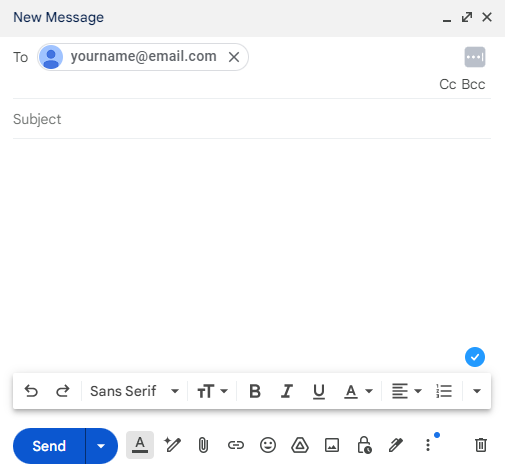
WordPress makes it easy to create clickable email links. Just open a WordPress post, type out and highlight your email address, then press Ctrl+K to create a mailto link.
Want more specifics?
Let’s take a look at the process step by step.
How to add an email link in WordPress
There are two ways to add an email link in WordPress: the hyperlink button and HTML.
We’ll walk you through both methods, but it’s worth mentioning again that using mailto links isn’t the most secure practice due to the risks of spam bots and other malicious activity.
If you’re uncomfortable with this and want a better way to link emails, we recommend skipping ahead to the bottom to learn about the advantages of contact forms.
Otherwise, let’s take a closer look at adding an email link in WordPress.
Adding email links in WordPress using the hyperlink button
This is the fastest and easiest method of linking to an email in WordPress.
Step 1: Write your anchor text. Let’s use “contact us today.”
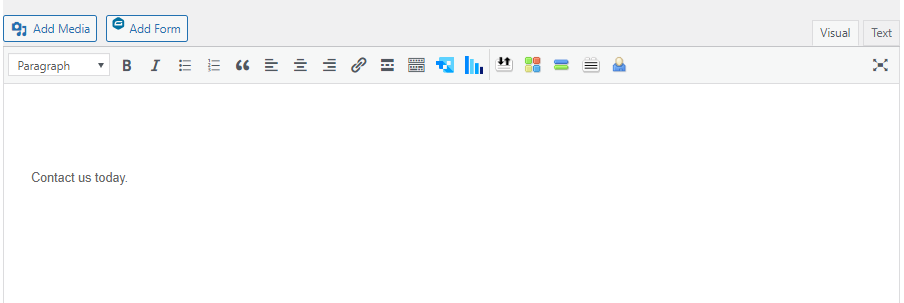
Step 2: Highlight your text and click the hyperlink button at the center of the editing box. You should see something like this:
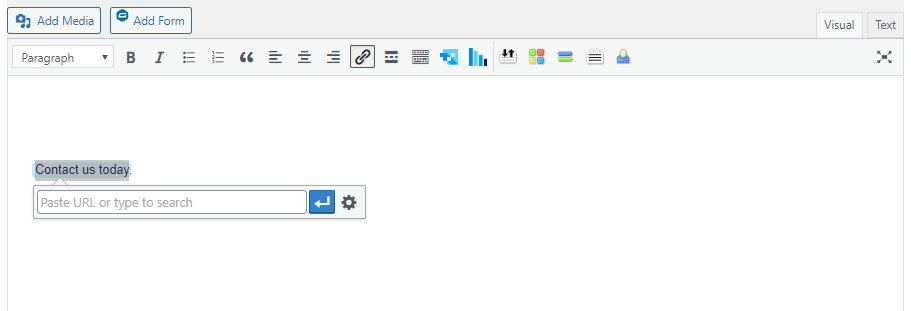
Step 3: Type in mailto: followed by your email address. There should be no spaces.
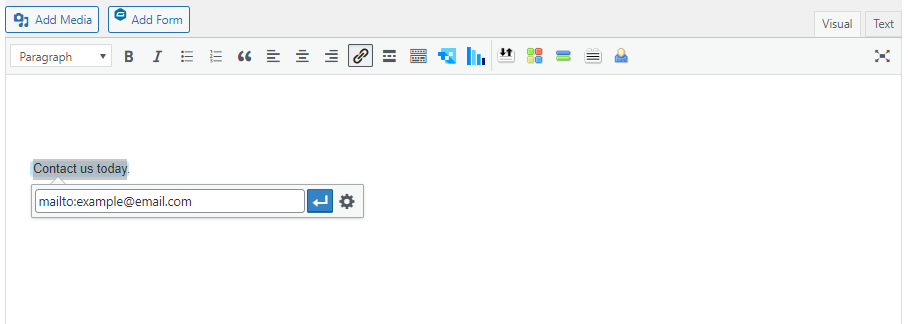
Step 4: Press Enter (or click the blue arrow). Your mailto link is ready to go.
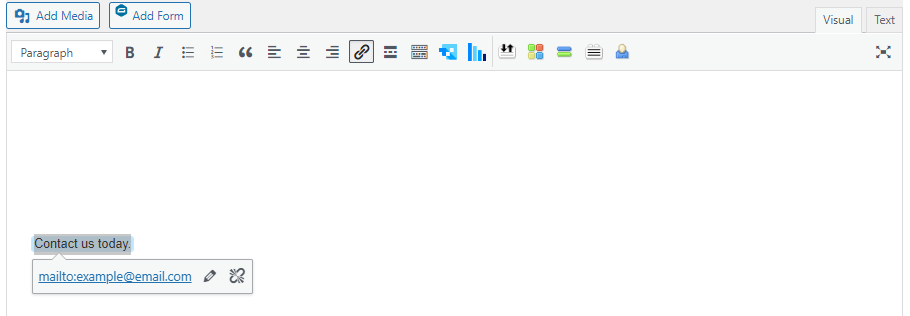
Step 5: Click Publish or Update in WordPress to confirm your changes. The WordPress link to email process is complete.
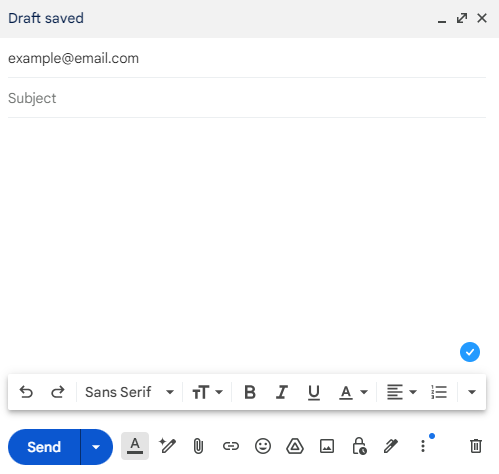
Adding email links in WordPress using HTML
You can also use code to embed a mailto link. This is the only way to add a clickable email link to a text widget or WordPress theme file.
For the sake of clarity, let’s assume you’re using this method on a WordPress post.
Step 1: Select the post you want to edit and select text instead of visual. It should look like this:

Step 2: Add the following code to the text box:
<a href=”mailto:[email protected]”>Contact us today</a>

Step 3: Click Update or Publish. Your mailto link is now live.
If you want to, you can also customize your mailto links with subject lines, images, and more.
Let’s discuss these in the section below.
Customizing email links
With a pinch of code and some elbow grease, you can customize your mailto links with colors, styles, and even pre-populated text.
Here are three ways to customize your email links.
1. Pre-populate subject lines in email links
Here’s how to link an email in WordPress and pre-populate subject lines for users.
Step 1: Paste your mailto link into a WordPress post. It should look something like this:
<a href=”mailto:[email protected]”>Contact us today</a>
Step 2: Add ?subject= to the end of your email address. Then, add the word you want in the subject line after the = symbol. Your code should now read:
<a href=”mailto:[email protected]?subject=Hello”>Contact us today</a>
Here’s what this looks like:

Step 3: If your subject line contains spaces or special characters, you need to encode them. Otherwise, they won’t appear. To add a space, you’d write %20. Special characters have their own encodings — the exclamation mark, for example, is %21.
So if you wanted the subject line to be “Hello there!” you would write the following:
<a href=”mailto:[email protected]?subject=Hello%20there%21″>Contact us today</a>
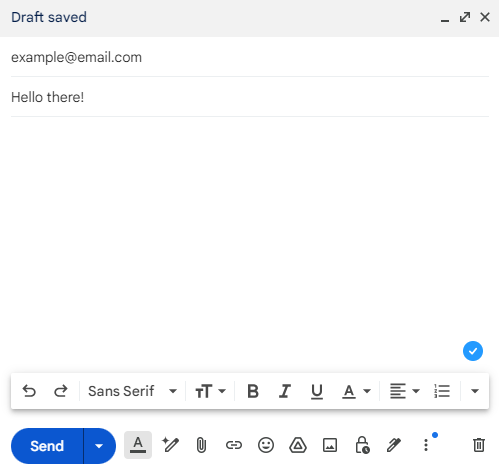
2. Customizing email link appearance and texts
If you want to change the color or style of your mailto link, you have to use CSS (aka Cascading Style Sheets).
Luckily, this isn’t difficult to do.
Let’s say you want to create an orange link in italics:
Step 1: Start with your basic mailto code.
<a href=”mailto:[email protected]”>Contact us today</a>
Step 2: Next, add style= after the href field. You need to include the color and text-decoration friends, followed by a semicolon.
Here’s what that looks like:
<a href=”mailto:[email protected]” style=”color: orange; text-decoration: italic;”>Contact us today</a>
This should be the final result:

3. Using images or icons
If you don’t want to use basic anchor text, you can turn an image or icon into a contact button.
Step 1: Download the image you wish to use (or remember the name of the image). Ours will be contact-button.png.
If you’re not sure what your file URL is, click Add media, select the image, and copy URL to clipboard.

Step 2: Insert an <img> tag inside your <a> tag. For example:
<a href=”mailto:[email protected]”><img src=”contact-button.png” alt=”Contact us today”></a>
Your result should look something like this:

Common issues with email links in WordPress
Adding a simple email link in WordPress may seem like a quick win for website owners looking to make contact information readily available. However, it can come with several downsides, for both user experience and security. Here are some common issues to keep in mind:
- Inconsistent user experience across devices: Clicking a WordPress mailto link may open the wrong email client or none at all, especially on shared or public devices. That’s because mailto links rely on the user’s system settings to launch a default email app. This may be misconfigured or set to an unused application like Outlook or Apple Mail.
- Increased exposure to spambots and email harvesting: Using a visible email link in WordPress exposes your raw email address to web crawlers. Automated bots can scrape these addresses and flood inboxes with spam, phishing attempts, and unwanted promotional emails.
- No fallback for users without email clients: Many people browse on mobile or public computers where no default email client is configured. For them, clicking the link does nothing — no popup, no warning — leading to frustration, confusion, and missed opportunities.
- Manual updates required across multiple pages: If your address changes, every individual link to email in WordPress must be manually found and updated. This becomes tedious and error-prone on larger websites, especially compared to contact forms, where one update can handle all submissions.
- Absence of modern features: Unlike contact forms, mailto links can’t validate inputs, segment users with conditional fields, or integrate with analytics and lead tracking tools. That means lost insights on user engagement and zero data on how often your email link is used.
Best WordPress contact form plugins
Given the drawbacks we’ve covered, it’s clear that the traditional approach of linking to an email in WordPress creates more problems than it solves.
WordPress mailto link implementations simply can’t compete with modern user expectations and security requirements. That’s why contact forms are the smarter alternative.
They protect your email address, provide better UX, and support lead generation features you simply can’t get from a basic email link in WordPress.
Let’s explore some of the best WordPress email marketing plugins that offer contact forms to replace those vulnerable mailto links.
1. Omnisend
Best for email list growth + automation
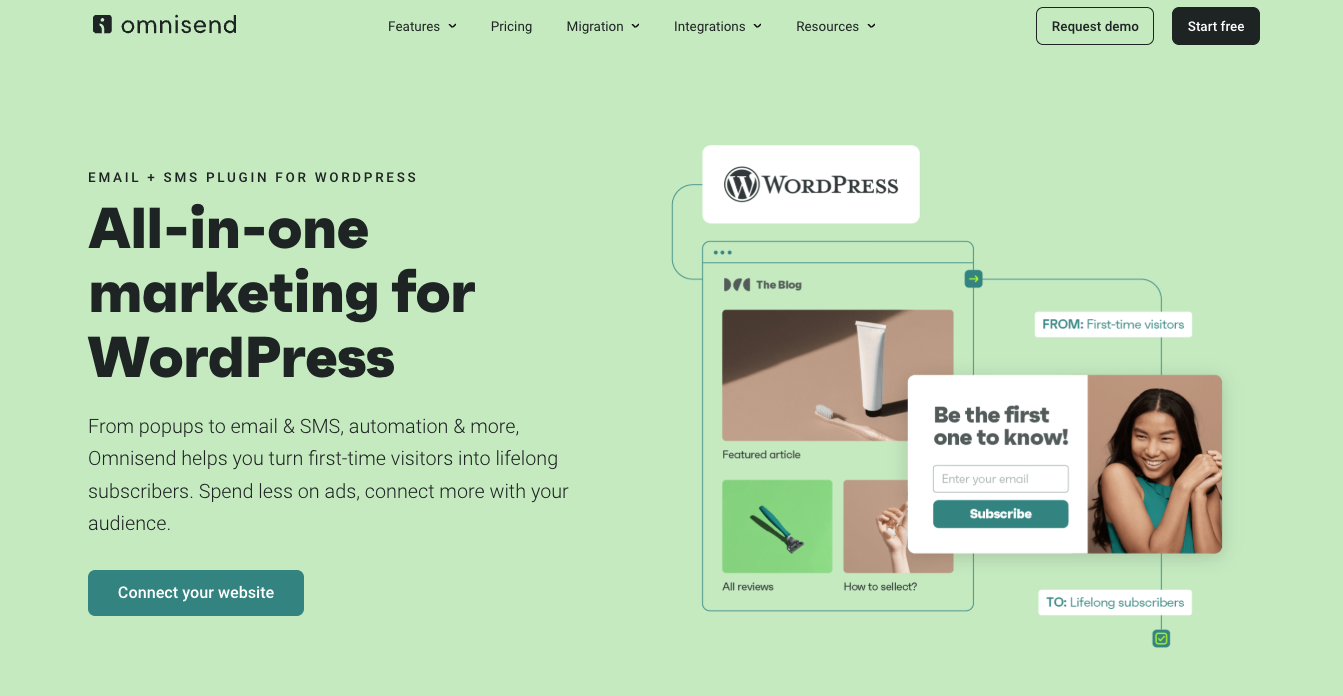
Omnisend is a powerful email and SMS marketing platform that eliminates the need to expose email addresses through public links.
Its customizable signup forms safely collect and store addresses while enabling automated follow-ups, keeping your inbox protected from spam.
You can launch popups, mobile-friendly forms, and gamified tools like the Wheel of Fortune, all with a forever-free plan. With hundreds of templates and a $68 average ROI per dollar spent, it’s a strong alternative to a basic WordPress mailto link.
“80% of our online visitors are on a mobile device, so to be able to target those with instant messaging was a great option. Combined with email, it was a powerful combination. Our mobile form was hovering at about the 18% signup rate in Klaviyo. We’re now up to about 32% at Omnisend using their multi-step forms. It was also very easy to set up with the step-by-step instructions and support given by Omnisend.”
Vape Superstore achieved a 77% increase in signup rates by switching to Omnisend. Read the full case study here.
2. Jetpack
Best for quick AI-assisted form creation
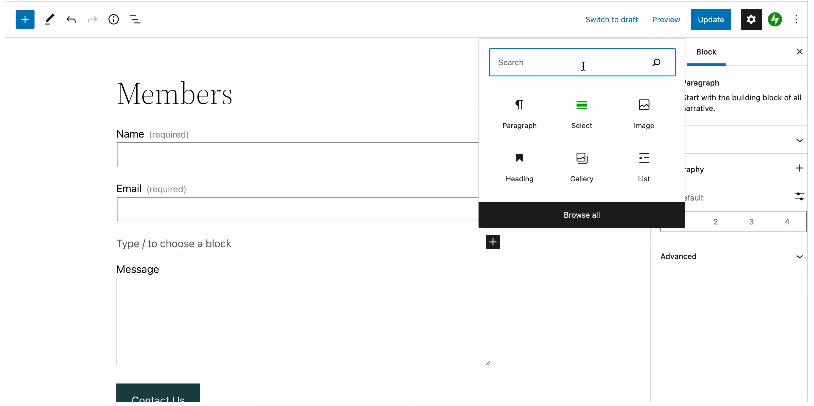
Jetpack offers contact forms that are uniquely integrated with AI. Once you supply a prompt with your needs and parameters, it immediately attempts to create a custom form layout.
But there are tradeoffs. You only get 20 free AI requests, prompt tuning has a steep learning curve, and Jetpack isn’t a full CRM or email marketing solution. If you’re after automation, analytics, or segmentation, you’re better off using a more comprehensive platform built for growth.
3. Ninja Forms
Best for payment-enabled forms on a budget
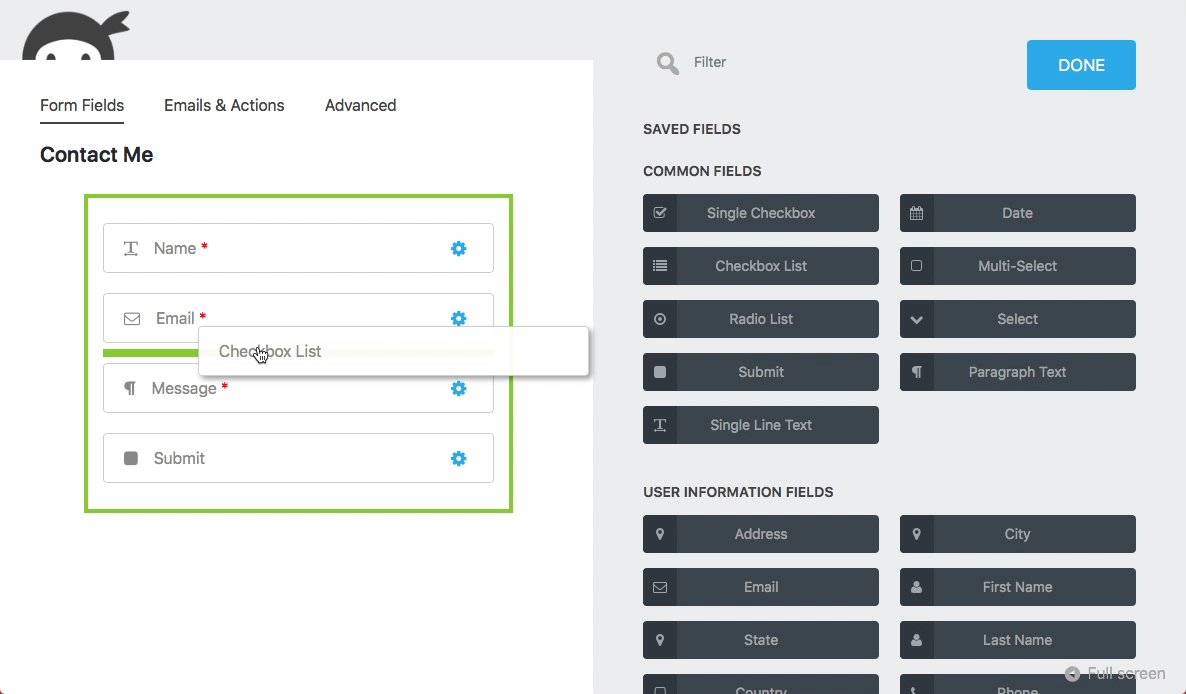
Ninja Forms is a drag-and-drop contact form builder and a low-code solution for those unfamiliar with HTML. You can also set up payment forms with sites like PayPal or Stripe, which may be useful if you’re an ecommerce site taking online payments or donations.
However, you should know Ninja Forms only serves one function: to build forms on your website. You won’t have access to other tools like advanced email automations, SMS functionality, or web push notifications.
4. Contact Form 7
Best for developers or advanced users
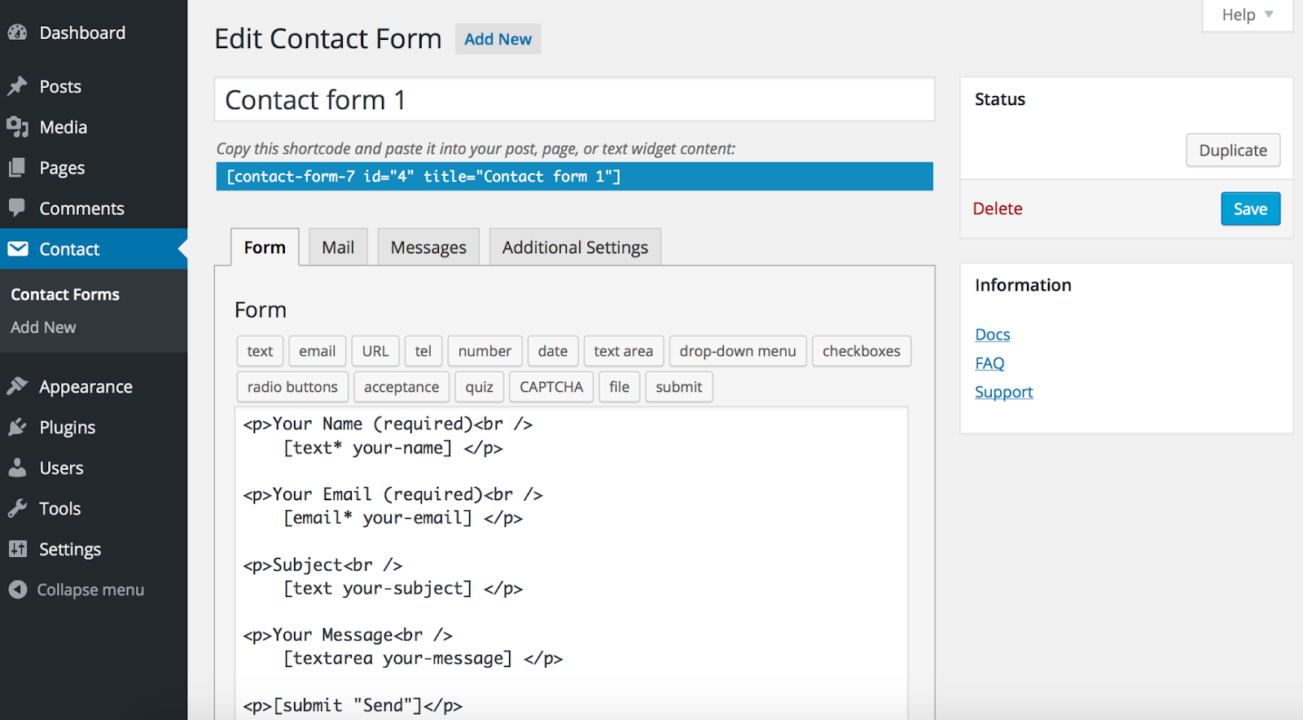
Contact Form 7 is a WordPress plugin supporting verification tools like CAPTCHA and Akismet spam filtering. If you want to save submitted contact forms for future use, you can also download its companion app Flamingo.
While Contact Form 7 may be a good fit for experienced builders, it’s not always a friendly option for those without coding experience. It’s also the subject of many poor reviews — mostly due to its unsafe email configuration.
Quick sign up | No credit card required
Avoiding spam and protecting email addresses
If you’re still set on mailto links instead of contact forms, please don’t wait to find additional spam protection.
Email encoder plugins will be key for your safety.
You may want to investigate solutions like:
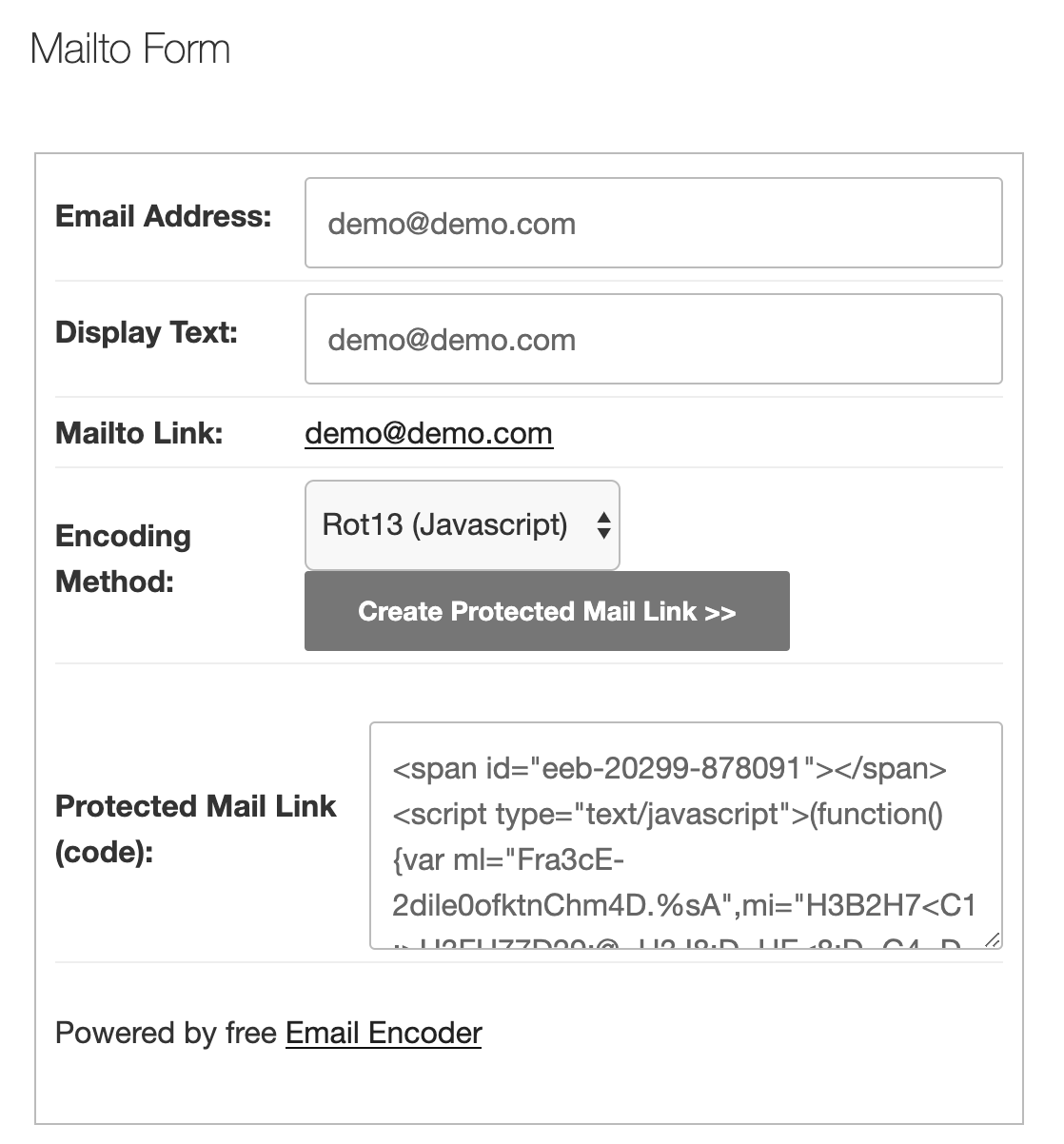
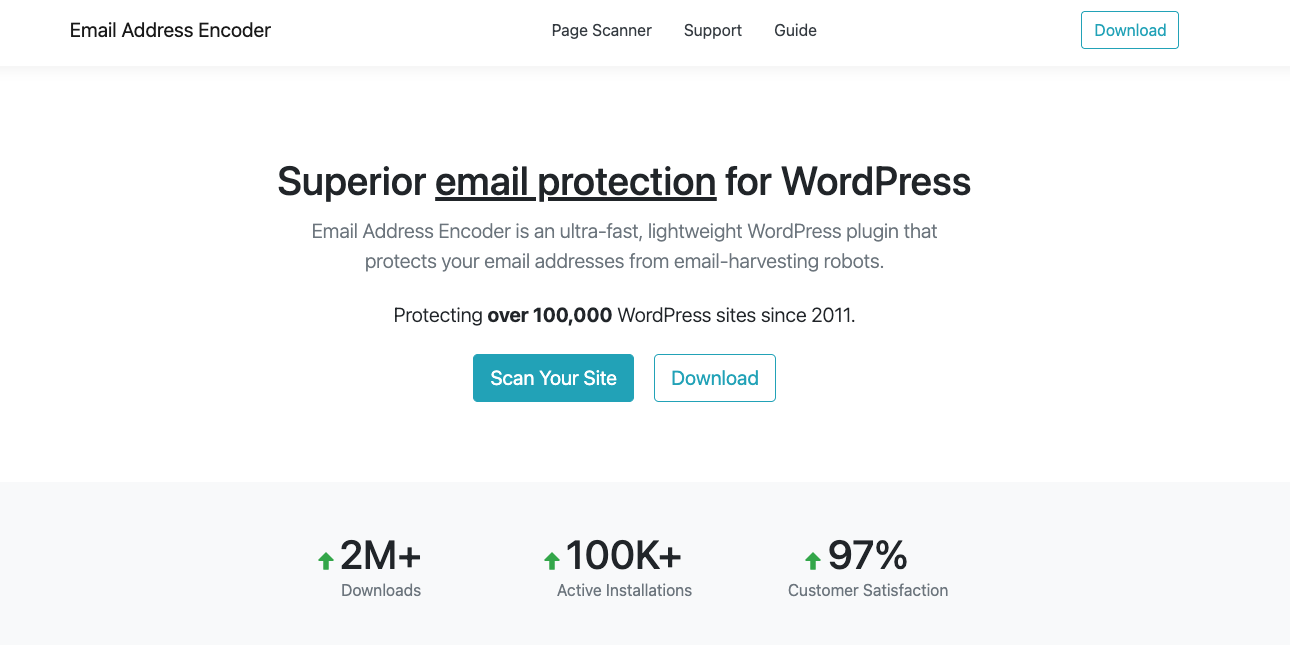
Remember: posting your email address as a mailto makes it easy for spammers to harvest it. This can lead to your inbox receiving huge volumes of spam emails or becoming the target of malicious attacks.
Advantages of contact forms over direct email links
As we’ve discussed, it’s better to create a contact form instead of dropping mailto links on your website. It’s not just about the safety factor — speed and convenience are also major benefits.
Compared with a mailto link, a contact form can:
- Cut back on spam: Spambots can harvest mailto links and repurpose the addresses for malicious purposes. Contact forms, especially those with CAPTCHA or other anti-spam measures, are much less susceptible to this.
- Improve user experience: Contact forms are a quick and easy way for visitors to reach out without leaving your website. It’s a seamless experience and more user-friendly compared to clicking on a mailto link and navigating to an inbox.
- Organize and collect data: Multi-step contact forms and signup forms help you capture information for future use. You can create specific fields for names, phone numbers, and subject lines to store necessary details in an organized manner.
- Add customization and branding: You can customize a mailto link, but not in the same way as a contact form. It’s possible to change the colors or backgrounds as well as form fields based on the type of information you need.
- Automate responses: With contact forms, you can set up automated responses to acknowledge the receipt of users’ messages. This provides immediate feedback to senders — something you can’t do with mailto links.
- Integrate with CRM and marketing tools: If you use customer relationship management (CRM) systems and marketing tools, you can easily integrate them with contact forms. This streamlines workflows and automates repetitive tasks like adding contacts to a mailing list or database.
- Ensure accessibility for users without a default email client: Not all users set a default email client, which is required for mailto to work effectively. Since contact forms are universally accessible through web browsers, you don’t have to worry about potential snafus.
Skip the spam, grow your list smarter
We’ve explored how to link an email in WordPress using traditional mailto methods, but one thing remains clear. Contact forms offer superior protection, functionality, and user experience compared to exposed email links.
Adding a mailto link in WordPress might feel like the easy option, but it’s far from ideal. From spam exposure to poor UX and lack of tracking, it simply doesn’t support modern engagement goals.
Omnisend, on the other hand, offers a smarter solution. It’s intuitive without being clunky, with professionally designed forms built to convert. Plus, there’s no exposure to spambots, clunky email clients, or extra tools for following up.
With powerful marketing automation, a generous free plan, and seamless integration with your tech stack, Omnisend lets you grow your list and your business without risk.
Quick sign up | No credit card required
TABLE OF CONTENTS
TABLE OF CONTENTS


No fluff, no spam, no corporate filler. Just a friendly letter, twice a month.

 OFFER
OFFER







